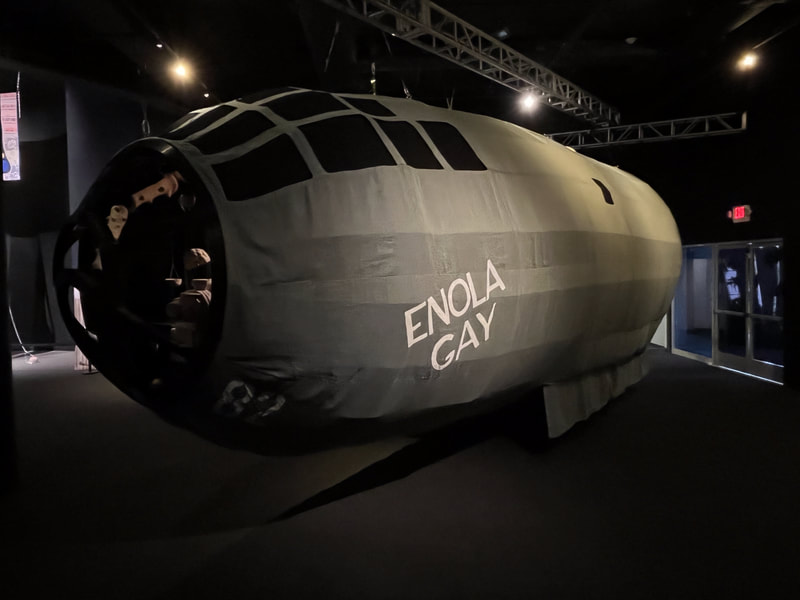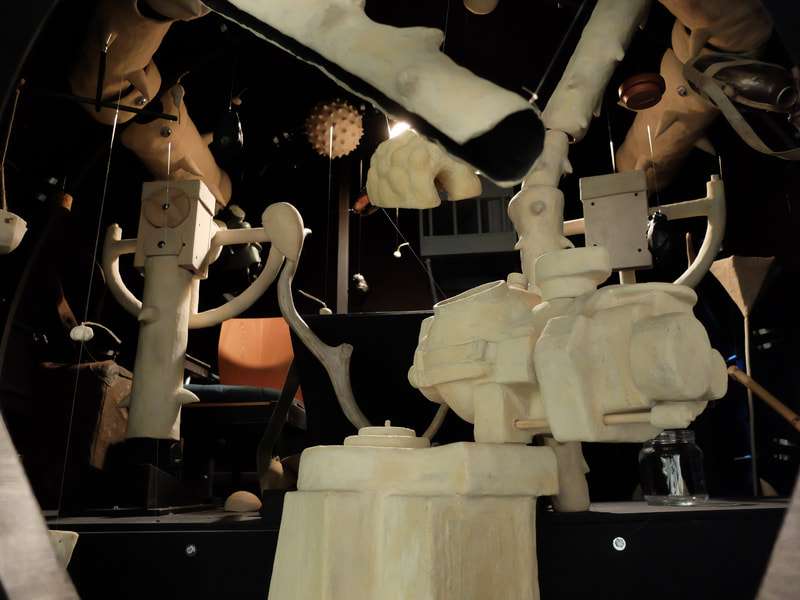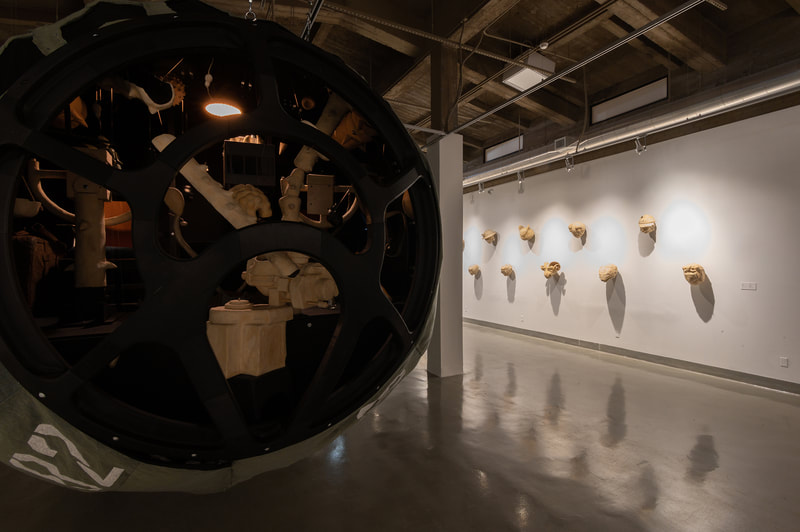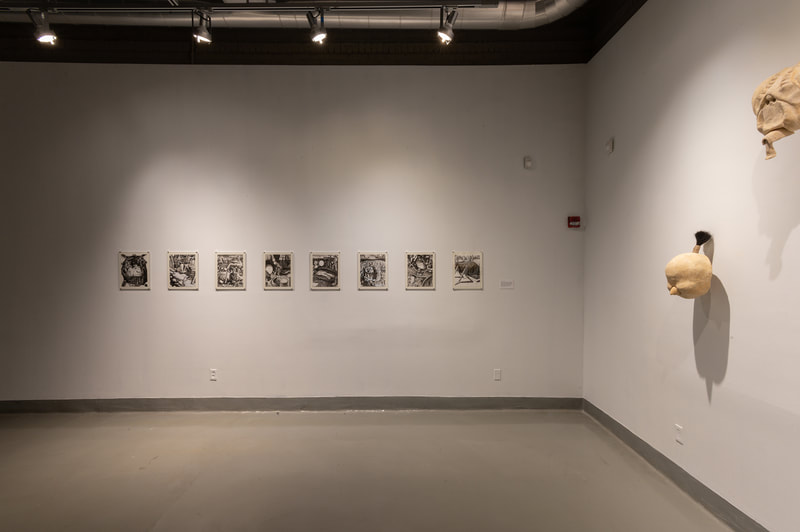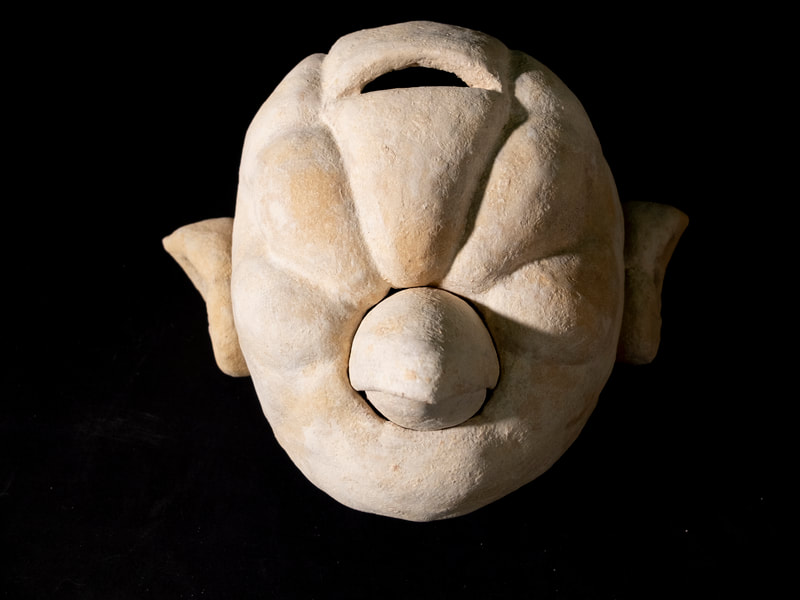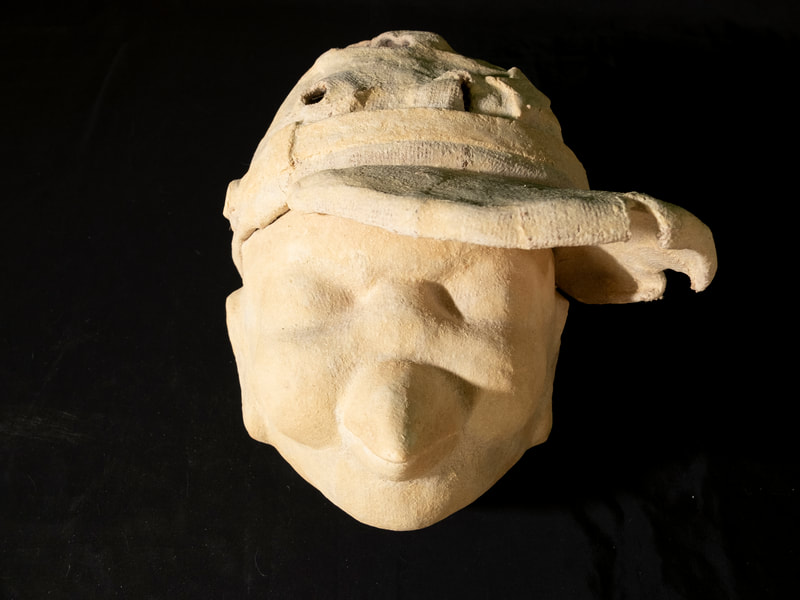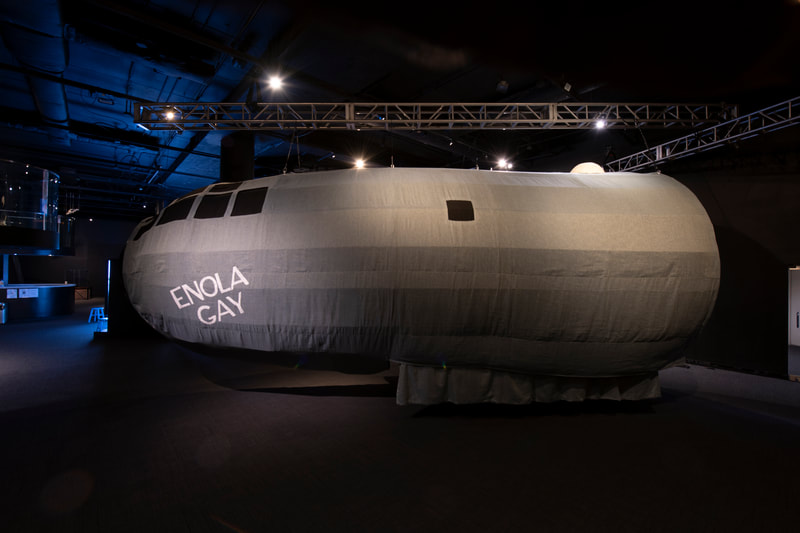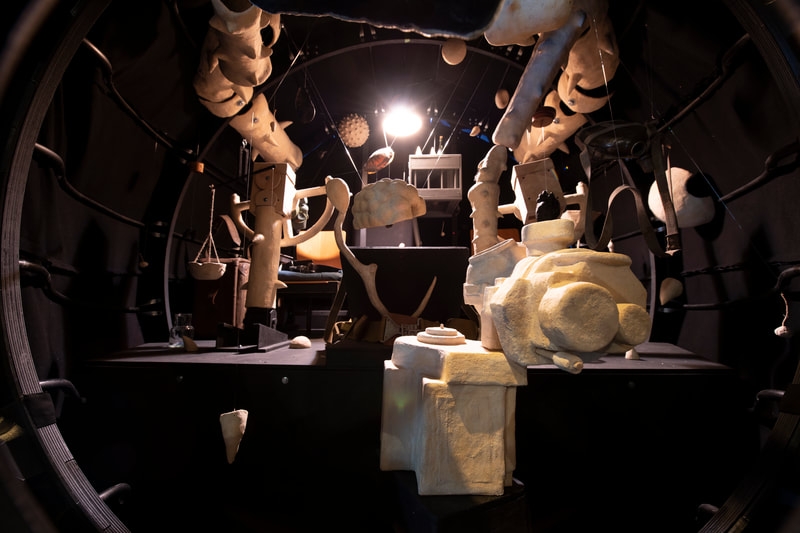ENOLA'S HEAD
2021-22
Linen fabric, blackout fabric, wood, electric conduit, plastic, vintage lump shade, vintage bomber seat belts, vintage protected hood, vintage backpack, vintage canteen, glass bottles, bamboo, legless seat backs, turtle shell, Elk’s horns, wood powder, wheat flour, wood glue, hemp cloth, paper clay, projector, amplifier, speakers, video
9' 6" x 24’ 5" x 10' 9 5/8" (This work is installed 12” above the floor)
Outline: Rubin Center for the Visual Arts
Review (Southwest Contemporary)
Interview
Process Talk
The details of Drawings
Hawaii Triennial 2022 (Feb 18 - May 8, 2022)
ENOLA'S HEAD was a commissioned work of the Rubin Center for the Visual Arts, the University of Texas at El Paso. Supported by the University of Texas at El Paso and by the Andy Warhol Foundation Grant. It travels to Hawaii Triennial 2022 and was exhibited at Castle Building in Bishop Museum, Honolulu in 2022.
In 1945, the Enola Gay, a Boeing B-29 Superfortress, dropped the first atomic bomb on Hiroshima. Three days later, Bockscar, another B-29 dropped the second on Nagasaki. These bombings resulted in more than 210,000 deaths that year and many more over time. Here, the aircraft’s nose is reimagined as a suspended theater housing an animated film that presents the dangers of nuclear warfare through the lens of fantasy. The story’s characters are inspired in part by Gigaku, a now-extinct genre of Central Asian masked performance once popular in Japan. When occupied, the theater itself transforms into a mask of the Enola Gay. The tale told within centers around atomic bomb victims not only in Japan but in the United States, where the weapons were tested and uranium, plutonium, and other materials were produced. These allegorical characters, presented as humanlike animals, represent real civilians, workers, activists, downwinders, and others affected by nuclear development before the first atomic bomb was dropped on Hiroshima and long after. While the hazards of nuclear energy within our own world are often invisible, the world within ENOLA’S HEAD seeks to reveal the reality that we cannot see. To create this project, the artist conducted research on-site through visits to various locations that played significant roles in the atomic bomb’s history, including our own desert region. During these visits, she interviewed Japanese survivors, American victims, and activists from both countries. Gaku Tsutaja dedicates her work to “all the deceased hibakusha (victims), hibakusha who survived and are still suffering, and the next generation who may have heavier issues to deal with.” She would like to thank the hibakusha, activists, educators, journalists, historians, and physicists for the interviews.
Currently based in New York City, Gaku Tsutaja was born in Tokyo, Japan. In 1995, while she was working toward her BFA in Tokyo, a major earthquake struck Japan. That same year, the Tokyo subway sarin attack happened, the largest-scale disaster caused by nerve gas in peacetime history. In 2011, following both the Fukushima Daiichi nuclear accident and a misfortune in her personal life, she returned to Japan for a year. It was after these experiences that she began centering her work around the theme of disasters, both personal and collective. Since 2017, her focus has been on conveying the dangers of nuclear energy through her work. Rather than depicting disasters shortly after they occur, she waits for time to pass to capture the full extent of their lasting impact.
ENOLA’S HEAD was generously supported by grants from The Andy Warhol Foundation for the Visual Arts and the Texas Commission on the Arts. It was constructed in creative collaboration with the following individuals and organizations: Patrocinio Binuya; Peter Brauch; Fab Lab El Paso; Cynthia Gutierrez-Krapp; Rubin Center Exhibitions Coordinator Jose Krapp and Ulterior Gallery, NY. Special thanks to production assistants Robert Dennis, Eber Sanchez and Dilan Torres Jimenez and the Rubin Center staff and interns.
The artist would like to acknowledge the contributions of the following individuals who shared experiences and expertise that contributed to the making of this work: Tom Carpenter, Deb Abrahamson, Twa-le Abrahamson-Swan, Tom Bailie, Abe Garza, Bertolla Burgarin, Landon Wilkey, Kazumi Mizumoto, Shunichiro Arai, Norihisa Miyamoto, Chinobu Takami, Satoshi Hirose , Katsuma Yagasaki, Fumio Okada, and Takayuki Yamazaki
I want to say thank you Bo Jacobs specifically. Without his advice, it would have been impossible for me to put together this complex and long history.
– Gaku Tsutaja
From the Wall Text at the Rubin Center
Currently based in New York City, Gaku Tsutaja was born in Tokyo, Japan. In 1995, while she was working toward her BFA in Tokyo, a major earthquake struck Japan. That same year, the Tokyo subway sarin attack happened, the largest-scale disaster caused by nerve gas in peacetime history. In 2011, following both the Fukushima Daiichi nuclear accident and a misfortune in her personal life, she returned to Japan for a year. It was after these experiences that she began centering her work around the theme of disasters, both personal and collective. Since 2017, her focus has been on conveying the dangers of nuclear energy through her work. Rather than depicting disasters shortly after they occur, she waits for time to pass to capture the full extent of their lasting impact.
ENOLA’S HEAD was generously supported by grants from The Andy Warhol Foundation for the Visual Arts and the Texas Commission on the Arts. It was constructed in creative collaboration with the following individuals and organizations: Patrocinio Binuya; Peter Brauch; Fab Lab El Paso; Cynthia Gutierrez-Krapp; Rubin Center Exhibitions Coordinator Jose Krapp and Ulterior Gallery, NY. Special thanks to production assistants Robert Dennis, Eber Sanchez and Dilan Torres Jimenez and the Rubin Center staff and interns.
The artist would like to acknowledge the contributions of the following individuals who shared experiences and expertise that contributed to the making of this work: Tom Carpenter, Deb Abrahamson, Twa-le Abrahamson-Swan, Tom Bailie, Abe Garza, Bertolla Burgarin, Landon Wilkey, Kazumi Mizumoto, Shunichiro Arai, Norihisa Miyamoto, Chinobu Takami, Satoshi Hirose , Katsuma Yagasaki, Fumio Okada, and Takayuki Yamazaki
I want to say thank you Bo Jacobs specifically. Without his advice, it would have been impossible for me to put together this complex and long history.
– Gaku Tsutaja
From the Wall Text at the Rubin Center
"ENOLA'S HEAD" traces the history of nuclear weapons from World War II, the Cold War to the present, and consists of the episodes of the Japanese and American victims, historians, activists, disarmament experts, physicists, journalists, and educators whom I actually met and interviewed. I included many stories that are not well known in nuclear history. The story takes the approach of science fiction and is driven by 14 non-human character with masks that remind ancient artifacts. I created these masks referring to the material and production process of the extinct culture called Gigaku that was performed in Japan in the 7th and 8th centuries via the Silk Road from Central Asia. The theater of ENOLA GAY refers to the large lion that appears in Gigaku. Just as performers entered the lion of Gigaku, the viewers enter ENOLA'S HEAD head and experience a long story about nuclear weapons. It is the story of a world where reasonably committing mass murder is called civilization.
In the work, all country names and place names are set as fiction, and personal names do not appear. The real names are the historical devices and tools such as "ENOLA GAY," "B-29", "Norden Bombsight", "Fat Man", which were the revolutions due to the development of science and technology. Also, the historical projects such as "Manhattan Project," "Trinity," "Life Span Study," "Castle Bravo," and "Green Run" are the real names. The viewers are conceived to be able to compare stories happening in another world with their own world and imagine the reality that has not yet been seen, and what may happen in the future.
In the work, all country names and place names are set as fiction, and personal names do not appear. The real names are the historical devices and tools such as "ENOLA GAY," "B-29", "Norden Bombsight", "Fat Man", which were the revolutions due to the development of science and technology. Also, the historical projects such as "Manhattan Project," "Trinity," "Life Span Study," "Castle Bravo," and "Green Run" are the real names. The viewers are conceived to be able to compare stories happening in another world with their own world and imagine the reality that has not yet been seen, and what may happen in the future.
Installation at Bishop Museum, Hawaii Triennial 2022
Courtesy of the artist and Hawai‘i Contemporary. Photo: Christopher Rohrer
© 2015 Gaku Tsutaja

